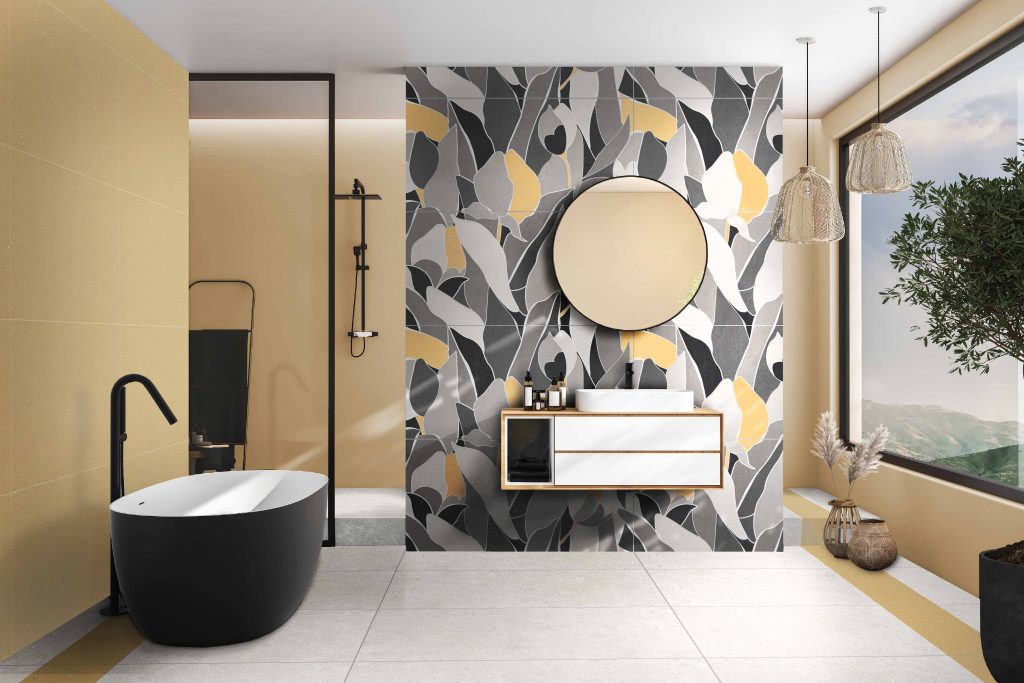Bathroom wall tiles: Designs for a Luxurious, Low Maintenance Space
Hunting for Bathroom Wall Tiles? Let's Help You Decide!
The ideal bathroom wall tiles should make the space feel clean, safe, and inviting and offer functional benefits. For example, tiles protect your bathroom walls from moisture damage. Various factors influence the selection of the perfect tiles.

Let’s explore the following sections to learn more.
Elevate Your Bathroom Aesthetics
Tile Size Matters: Make the Right Choice!
Larger tiles (with measurements: 800x2400mm, 600×1200 mm, 800×1600 mm, 1200×1800 mm) create a seamless, elegant look and make a small bathroom feel more spacious. For smaller bathrooms, choosing larger tiles can help open up the space. The most common sizes for bathroom walls are 60x120cm, 60x60cm, 30x60cm, and 30x45cm. Mix large and small tiles in larger bathrooms for a balanced and stylish design.
Play with Colours!
If your bathroom has limited natural light, choosing lighter tiles in shades like white, pink, or beige is best. These colours help brighten the space by reflecting light, preventing it from feeling dark and gloomy. On the other hand, if your bathroom gets plenty of natural light from a window, you can experiment with darker or nature-inspired hues like leafy green, purple, or ocean blue for the walls.
Balance glossy and matte tiles to create visual interest. Glossy tiles reflect light, helping rooms appear larger, while matte tiles offer better grip and add a sleek, modern touch. If you aim for a natural aesthetic, consider nature-inspired tiles like stone-effect, slate, travertine, natural stone, or marble-effect tiles. These options will give your bathroom a grounded, earthy feel.
Best Options for Bathroom Wall Tiles with Easy Maintenance
Maintenance and hygiene are essential in both home and commercial bathrooms. Since tiles cover most of the space, they should protect against moisture and prevent mould growth to ensure safety and cleanliness. If your bathroom has poor ventilation, it may struggle to dry properly after use. In this case, consider using bathroom/kitchen wall tiles with an anti-bacterial coating to help prevent bacteria and mould growth.
Vitrified and ceramic wall tiles
Simplify the task of keeping your bathroom clean and dry. Vitrified and ceramic wall tiles have hard, glazed surfaces that are nearly waterproof, preventing moisture absorption. This characteristic significantly reduces the likelihood of mould and bacteria growth on the tiles.
Porcelain and ceramic wall tiles
These tiles are favoured options for shower floors because of their strength and water resistance. Crafted from dense materials, they are highly resistant to water, stains, and scratches. They offer excellent design versatility in various colours, patterns, and sizes. Plus, many come with textured finishes that help prevent slipping, enhancing safety.
High-Gloss tiles
Typically, high-gloss tiles are ideal for bathroom walls because they can easily be wiped clean of water and soap stains. You might opt for decorative wall tiles like rockers or matte-finish tiles in dry areas. 3D elevation tiles are also trendy for bathrooms, particularly for accent walls. Choosing decorative wall tiles like glossy 3D-punched tiles can make it simpler to maintain the cleanliness of your accent or border decorations.
Anti-skid tiles
Anti-skid tiles are the best option for washroom floors. These tiles come with a special coating that enhances traction and reduces the possibility of slips and falls, making your washroom floor a safe space to walk on, especially for the aged and kids. Matte-finish tiles can also be used on bathroom floors as they are non-slippery when wet. Glossy tiles on the bathroom floor should be avoided at all costs since glossy tiles turn slippery when wet.
Remember that shower floors need comfortable tiles underfoot while providing enough grip to prevent slipping. Opting for small or mosaic tiles is usually an intelligent choice, as the extra grout lines enhance slip resistance without causing discomfort on your feet.
Glass Tile
Decorative wall tiles, such as glass tile, are becoming increasingly popular due to their beauty and variety of colours and finishes. Glass is an excellent option for showers since it’s durable, stain-resistant, and non-porous, even without a sealant or glaze. However, maintaining a glass-tiled shower can be challenging, as the surface can smudge easily, requiring regular buffing to remove fingerprints and residue from soaps and cleaners.
Remember that marble and limestone are not ideal for bathrooms, as they are very porous and easily stained or etched. These soft stone tiles need regular sealing and maintenance to protect them from damage caused by water and cleaning products.
Natural stone tile
Natural stone tile is crafted from granite, marble, slate, and travertine. Each type offers a distinct appearance and texture, making it a luxurious option for enhancing the beauty and elegance of a bathroom. However, it’s crucial to remember that natural stone is porous and needs regular sealing to guard against stains and water damage.
Key Insights
Choosing less slippery floor tiles is essential in areas prone to moisture, like bathrooms. Anti-skid or matte-finished tiles are ideal for flooring, while wall tiles must be durable enough to endure persistent moisture exposure. Additionally, modern bathroom tiles should have low water absorption to ensure longevity.
When choosing the ideal bathroom tile, pick a design you love. Next, measure your bathroom space to determine the correct size; mix 2-3 designs to create a unique decor concept instead of just one tile type.
